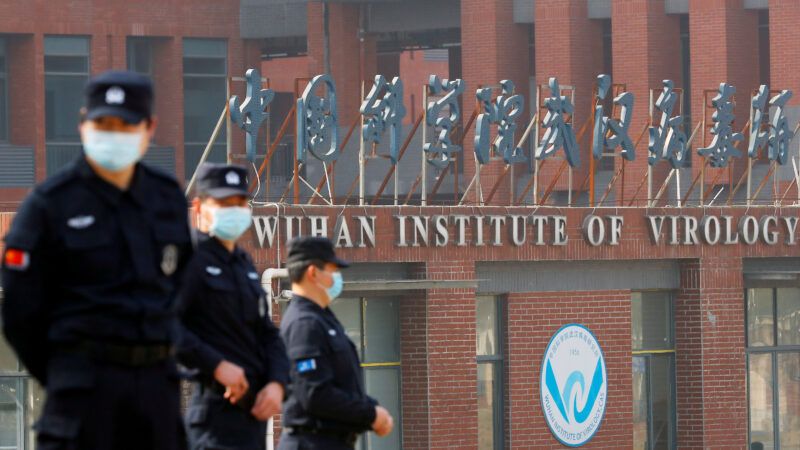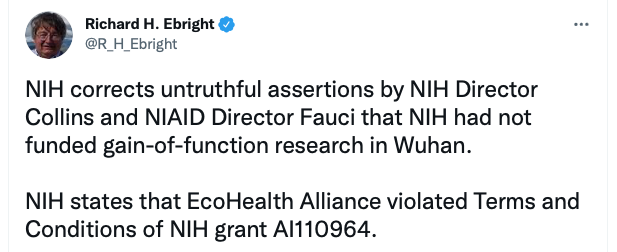More Evidence Emerges that the NIH Funded Coronavirus Gain-of-Function Research in China
What did Fauci know and when did he know it?

(THOMAS PETER/REUTERS/Newscom)
In a letter yesterday to Rep. James Comer (R–Ky.), National Institutes of Health (NIH) Principal Deputy Director Lawrence Tabak tepidly acknowledged that his agency funded coronavirus research at the Wuhan Institute of Virology. The money, channeled through the EcoHealth Alliance, supported scientists who modified bat coronaviruses so that they were "capable of binding to the human ACE2 receptor in a mouse model."
Basically, the Chinese researchers modified the spike protein of a relatively harmless coronavirus so that it would function as a key enabling the virus to open and invade cells in humanized mice. As it happens, the coronavirus responsible for the COVID-19 pandemic chiefly infects people by binding to our ACE2 receptors.
Calling this a "limited experiment," Tabak tried to minimize the risks of this research. But he admitted that the lab mice infected with the SHC014 W1V1 bat coronavirus—a synthetic viral construct designed to infect human cells—"became sicker than those infected with the W1V1 bat coronavirus." The NIH, Tabak added, determined that the research plan "did not fit the definition of research involving enhanced pathogens of pandemic potential (ePPP) because these bat coronaviruses had not been shown to infect humans." ePPP refers to gain-of function researchthat "aims to increase the ability of infectious agents to cause disease by enhancing its pathogenicity or by increasing its transmissibility."
Tabak's claim mirrors National Institute of Allergy and Infectious Diseases Director Anthony Fauci's congressional testimony in July that this research "was judged by qualified staff up and down the chain as not being gain of function." But pointing out that the original bat coronaviruses had not been shown to infect human beings appears somewhat disingenuous, because the Wuhan researchers were clearly seeking to deliberately modify bat coronaviruses so that they could infect human cells.
Tabak's letter notes that, "out of an abundance of caution," the NIH grantrequired that the "grantee report immediately a one log increase in growth." Or, to quote the document directly:
If any experiments proposed in this award result in a virus with enhanced growth by more than 1 log compared to wild type strains, you must notify your NIAID Program Officer and Grants Management Specialist immediately. Further research involving the resulting virus(es) may require review by the Department of Health and Human Services in accordance with the Framework for Guiding Funding Decisions about Proposed Research Involving Enhanced Potential Pandemic Pathogens.
Mikolaj Raszek, founder of the Canadian genomics analysis company Merogenomics, has written a careful dissection of the recently released NIH progress report on its EcoHealth Alliance coronavirus research grant. Raszek points out that "a log of 1 of any number is that same exact number (21 = 2) and therefore log 1 simply indicates no growth." In fact, a summary of the fourth year of research in the just released documentsreports that the mice infected with the SHC014 W1V1 virus ended up with much higher viral loads in their lungs. That would seem to mean that those experiments yielded "growth by more than 1 log compared to wild type strains."
According to Tabak's C.Y.A. letter, "EcoHealth failed to report this finding right away, as was required by the terms of the grant. EcoHealth is being notified that they have five days from today to submit to NIH any and all unpublished data from the experiments and the work conducted under this award." Given that the COVID-19 coronavirus apparently emerged in the city where NIH-funded research to enhance the infectivity of such viruses was taking place, why did it take so long for top NIH bureaucrats to get around to asking EcoHealth and the Wuhan Institute of Virology to disclose exactly what they were up to?
Tabak's letter went to great pains to point out that the COVID-19 virus is genetically distant from the viruses used in these experiments. "This analysis confirms that the bat coronaviruses studied under the EcoHealth Alliance grant could not have been the source of the [COVID-19 virus] and the COVID-19 pandemic," it concluded. That is likely right, but that does not take into account that such experiments trained researchers at the institute on how to easily manipulate the characteristics of coronaviruses. Did those researchers use their newly acquired skills in modifying coronaviruses to enhance their ability to infect human beings in experiments that have not been disclosed?
In any case, once it has the information it has ordered EcoHealth to supply, the NIH should immediately release it.
As Raszek concludes:
The NIH grants reveal that the work performed in Wuhan along with other institutes was geared towards generating coronaviruses more infectious to humans to learn about potential future threats which could then be subsequently monitored. This type of information makes Wuhan as the starting place of the current pandemic less plausible as a mere coincidence in light of the type of dangerous research with human pandemic potential that was being conducted in there.
Yes, indeed.
Given Fauci's congressional testimony denying that NIH funded gain-of-function research at the Wuhan institute, you should expect further inquiries into what Fauci knew and when he knew it. The Rutgers biologist Richard Ebright, a longtime critic of gain-of-function research, has made it clear what he thinks of the matter.

Whether or not the pandemic coronavirus leaked from the Wuhan institute's labs is yet to be determined. But the fact that the Chinese government continues to reject the World Health Organization's proposed follow-up investigation into the origins of the virus will certainly and properly fuel suspicions that it did.
